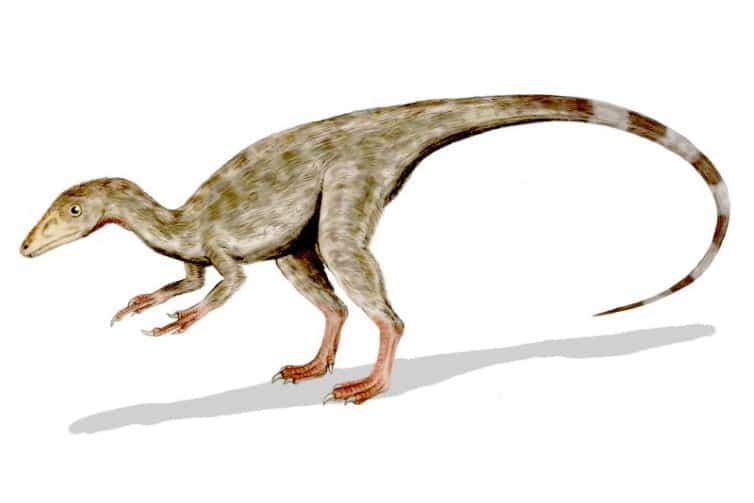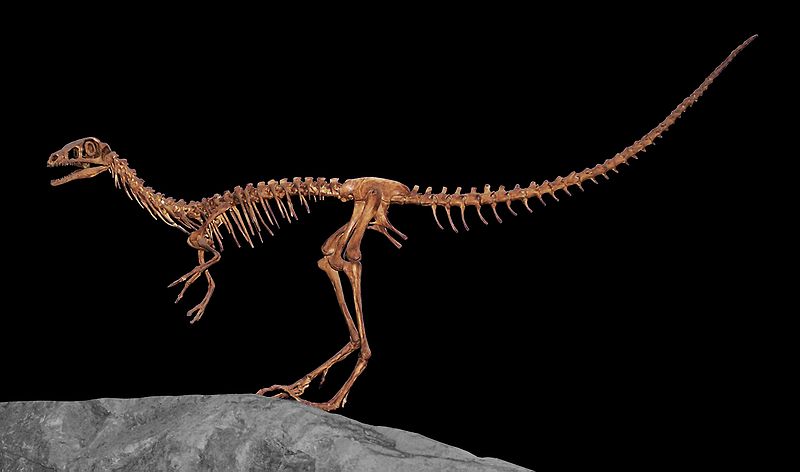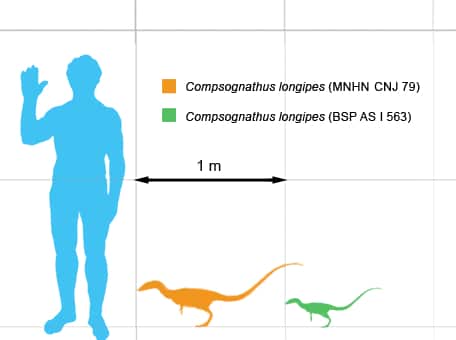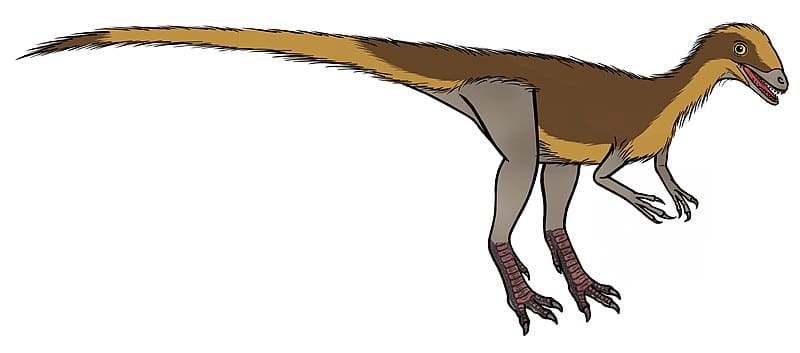In the grand tapestry of prehistoric life, the Compsognathus holds a unique thread. This petite predator was a testament to the diversity and adaptability of life. It hails from the Late Jurassic period and roamed central Europe. Its diminutive size, in stark contrast to the colossal creatures we often associate with the era of dinosaurs, offers a fresh perspective on the myriad forms life took in this bygone age.
Key facts
| Keyword | Fact |
|---|---|
| Compsognathus pronunciation | komp-so-NAY-thus |
| Meaning of name | “Elegant jaw” |
| Group | Theropoda |
| Type Species | Compsognathus longipes |
| Diet | Carnivore |
| When it Lived | 155.7 to 145.0 MYA |
| Period | Late Jurassic |
| Epoch | Late/Upper Kimmeridgian to Early/Lower Tithonian |
| Length | 2.1 ft |
| Height | 1.3 ft |
| Weight | 6-8 lbs |
| Mobility | Moved on two legs |
| First Discovery | 1850’s by Joseph Oberndorfer |
| Location of first find | Germany |
| First Described by | 1859 by Johann Wagner |
| Holotype | BSP AS I 563 |
Compsognathus Origins, Taxonomy and Timeline

This is a fascinating creature from the Late Jurassic period. Its name is derived from the Greek words ‘kompsos’, meaning ‘elegant’, ‘refined’ or ‘dainty’, and ‘gnathos’, meaning ‘jaw’. This name is a nod to the refined structure of its jaw–a feature that sets it apart from its contemporaries.
Belonging to the Theropoda group, the Compsognathus is a member of the Compsognathidae family. It has two recognized species: the type species Compsognathus longipes and Compsognathus corallestris.
The timeline is set in the Late Jurassic period, specifically between the Late/Upper Kimmeridgian and the Early/Lower Tithonian. This was a time when the Earth was dominated by dinosaurs and the Compsognathus, despite its small size, held its own in this era of giants.
Listen to Pronunciation
Discovery & Fossil Evidence
The first discovery was made in the 1850’s by Joseph Oberndorfer in Germany. This find was a nearly complete skeleton–a rarity in the world of paleontology. The Compsognathus was officially described in 1859 by Johann Wagner, marking its formal introduction to the scientific community.

Since the initial discovery, several other Compsognathus fossils have been found, notably in France. These finds have provided valuable insights into the life and habits of this small dinosaur. The fossils found include well-preserved skeletons, allowing for a detailed study of its physical characteristics and locomotion.
Compsognathus Size and Description
Despite its small stature, this was a creature of remarkable adaptability and survival instincts. Its size and physical characteristics set it apart from the typical image of dinosaurs as colossal creatures.
Short description of Compsognathus
It was a small, bipedal dinosaur known for its slender body and agile movements. Its head was elongated and narrow, home to a set of sharp teeth perfect for its carnivorous diet. The neck was long and flexible to aid in swift movements during hunting. Its vertebrae were robust, providing a sturdy framework for its body. The limbs were slender yet strong and designed for swift locomotion. The tail was long and likely used for balance during high-speed chases. The skin of the Compsognathus is believed to have been covered in scales, similar to modern reptiles.
Size and Weight of Type Species

This was a small dinosaur with an estimated length of about 2.1 feet and a weight of approximately 6.6 lbs. This size estimate is based on the well-preserved fossils that have been found, providing a clear picture of the dinosaur’s physical dimensions. Despite its small size, the Compsognathus was a formidable predator that used its speed and agility to hunt its prey.
The Dinosaur in Detail
This small carnivorous dinosaur was a creature of remarkable adaptability. Its slender body and agile movements allowed it to navigate its environment with ease, hunting smaller prey with precision. The elongated and narrow head, equipped with sharp teeth, was perfect for its carnivorous diet. The long and flexible neck aided in swift movements during hunting, allowing it to strike with surprising speed.
One of the unique features of the Compsognathus was its robust vertebrae. This provided a sturdy framework for its body in order to support its swift and agile movements. The slender yet strong limbs were designed for swift locomotion and allowed this predator to chase down its prey with ease.
The long tail of the Compsognathus likely served a crucial role in maintaining balance during high-speed chases. This, combined with its overall streamlined body shape, made it a highly efficient predator despite its small size.
The Compsognathus in its Natural Habitat

This dinosaur thrived in a diverse environment during the Late Jurassic period. The climate of Europe during this time was warm and humid with lush vegetation covering the landscape. With its small size and agile movements, it was well-adapted to navigate this dense vegetation, using it as cover to stalk its prey.
As a carnivore, it fed on smaller animals. Its sharp teeth and swift movements made it a formidable predator despite its small size. It was a bipedal dinosaur that moved swiftly on its two hind legs. This allowed it to chase down its prey with surprising speed.
It used its unique adaptations to play a crucial role in shaping the ecosystem of its time. Its presence influenced the behavior of other animals, shaping the dynamics of the prehistoric food chain. This small yet formidable predator was a testament to the adaptability and resilience of life.
It lived in a time when the Earth was dominated by dinosaurs. Its survival in such a competitive environment speaks volumes about its adaptability and survival instincts. The Compsognathus, with its unique features and behaviors, offers a fascinating glimpse into the diversity and complexity of life during the Late Jurassic period.
Interesting Points about Compsognathus
- Despite its small size, this was a formidable predator that could use its speed and agility to hunt down its prey.
- It is one of the few dinosaurs for which nearly complete skeletons have been found, providing a clear picture of its physical characteristics.
- The name translates to “Elegant Jaw,” in reference to the refined structure of its jaw.
- It lived in Europe during the Late Jurassic period, a time when the Earth was dominated by dinosaurs.
- It was a bipedal dinosaur, moving swiftly on its two hind legs.
Contemporary Dinosaurs
This creature of modest size but notable agility shared its world with an intriguing array of contemporaries. Among them were the Allosaurus, Cetiosaurus, and Hypsilophodon, each contributing to the intricate dynamics of their shared environment.
The Allosaurus had a considerably larger and more intimidating presence. It might have been a potential predator to the Compsognathus. This predator-prey relationship would have added a layer of complexity to the Compsognathus’ existence, requiring it to develop survival strategies and behaviors to evade such threats. On the other hand, the Cetiosaurus–an herbivore of significant size–would have been a neutral presence in the life of the Compsognathus. Their interactions, if any, would have been incidental. They might have occurred around shared water sources or feeding grounds.
The Hypsilophodon, similar in size to the Compsognathus, presents an interesting contrast. As an herbivore, they would not have been in direct competition for food resources, yet their shared size and possibly similar habitats might have led to other forms of interaction. The carnivorous diet of the Composgnathus might have led it to see the Hypsilophodon as potential prey–especially the young or the weak. These dynamics paint a vivid picture of the Compsognathus’ life, showcasing its survival instincts and adaptability in a world filled with diverse and fascinating contemporaries.
List Of All Dinosaurs
We have created a list of all dinosaurs we have covered here, sorted across the seven main groups of dinosaurs. We also include information about their type of diet, (omnivore, herbivore or carnivore) and the time they lived.
Frequently Asked Questions
It was one of the smaller dinosaurs, with an estimated length of about 2.1 feet and a weight of approximately 6.6 lbs (0.003 tons).
As a carnivore, the Compsognathus fed on smaller animals. Its sharp teeth and swift movements made it a formidable predator despite its small size.
This dinosaur lived in central Europe during the Late Jurassic period, specifically between 155.7 to 145.0 million years ago.
Joseph Oberndorfer made the first discovery in the 1850’s in Germany. This find was a nearly complete skeleton–a rarity in the world of paleontology.
The name translates to “Elegant Jaw” due to the refined structure of its jaw.
Sources
Article last fact-checked: Joey Arboleda,06-14-2023
Featured Image Credit: Nobu Tamura, CC BY-SA 3.0, via Wikimedia Commons
